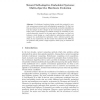Free Online Productivity Tools
i2Speak
i2Symbol
i2OCR
iTex2Img
iWeb2Print
iWeb2Shot
i2Type
iPdf2Split
iPdf2Merge
i2Bopomofo
i2Arabic
i2Style
i2Image
i2PDF
iLatex2Rtf
Sci2ools
ARCS
2007
Springer
2007
Springer
Toward Self-adaptive Embedded Systems: Multi-objective Hardware Evolution
Abstract. Evolutionary hardware design reveals the potential to provide autonomous systems with self-adaptation properties. We first outline an architectural concept for an intrinsically evolvable embedded system that adapts to slow changes in the environment by simulated evolution, and to rapid changes in available resources by switching to preevolved alternative circuits. In the main part of the paper, we treat evolutionary circuit design as a multi-objective optimization problem and compare two multi-objective optimizers with a reference genetic algorithm. In our experiments, the best results were achieved with TSPEA2, an optimizer that prefers a single objective while trying to maintain diversity.
ARCS 2007 | Evolutionary Circuit Design | Evolutionary Hardware Design | Reference Genetic Algorithm | Software Engineering |
| Added | 12 Aug 2010 |
| Updated | 12 Aug 2010 |
| Type | Conference |
| Year | 2007 |
| Where | ARCS |
| Authors | Paul Kaufmann, Marco Platzner |
Comments (0)

